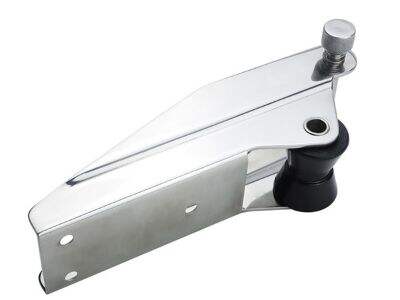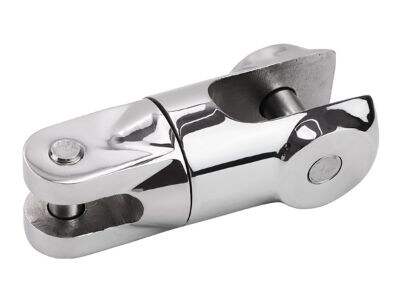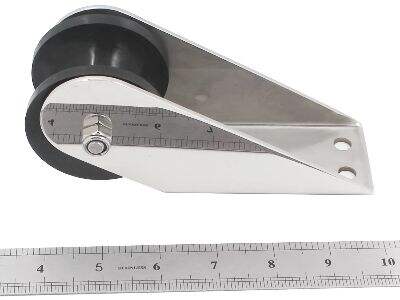Think of sailing a boat out on the open ocean with waves slapping against the sides, and the wind howling. Different components of the boat must be kept in their respective places, especially when it comes to rough conditions — and that includes where you locate your anchor roller
Makes rough conditions easier on the jeep and boat itself
A misaligned anchor roller is likely to damage the boat, or the anchor itself. The anchor can bang loudly on the sides of the boat creating dings and scratches in heavy seas. This weakens the grip of the anchor and adversely effects its ability to hold your boat in position. Taking care that the anchor roller is properly positioned can prevent this from happening, which will definitely keep your anchor (and boat) safe
Provides ideal set of wheels for difficult to launch / retrieve in testy seas
Correct alignment of the anchor roller also guarantees that the anchor is going to lower into and be pulled off each time in stormy seas. Improperly aligned Anchor Roller can cause the anchor to get stuck or jammed and it will be difficult to lower or raise the anchor. That is not always ideal, and in heavy conditions you may want to anchor promptly to avoid the boat from slipping away. Imagine deploying or retrieving an anchor safely and smoothly with a properly aligned anchor roller

At heavy weather, Improves the overall stability and control of vessel
As the security of the crew and passengers is at risk, heavy weather makes this need for stability and control imperative. Good alignment of the anchor roller is very important as it can certainly help improve the stability and control over your vessel in harsh climate conditions. When that anchor is buried good and aligned right, this helps the boat remain upright when its lost a bit at sea. This will help the captain to still keep control of the ship and allow it to drive through the storm safely
Minimize risk of anchor misalignment or dislodging in turbulent water
Another potential harm that misaligned anchor rollers can cause is for the anchor to slip out or be released in rough seas. The anchor may come loose, or it could be dislocated from the roller in shaky conditions, and will drag on the ocean floor. Both this can harm the anchor and the boat, and endanger the crew and passengers. Making sure the anchor roller lines up properly will help prevent your anchor from jamming or falling out of its pocket when things get bouncy, and ensures it's well-behaved while everyone else is hanging overboard for a swim

Improves the anchoring safety for crew and passengers in rough sea conditions
In short, correct anchor roller alignment is essential to ensure the safety of the crew and passengers during anchoring in high seas. Operating on the principle that accurate alignment of the anchor roller prevents damage to the anchor and hull, enables efficient deployment/retrieval, enhances overall vessel stability & control (read: no accidental dragging or dislodging), and in turn improves safety for you or anybody on board. Therefore, the next time you go sailing, amid the Oceans make sure that every anchor roller is aligned according to what may not claim out any live
To finish and summarize: Having the chain lay down on itself in a simple U-shape is absolutely crucial for safe anchoring under heavy weather. Making sure the anchor roller is in proper alignment keeps the anchor from damaging your vessel, lets you drop and haul short scope anchoring lines smoothly when one isn't on all chain, adds to overall stability/control of the vessel, lowers the odds for not setting or chafing an expensive rode against sharp corners/lip edges providing less fatigue on bear gear/lassoes-and more safety for those onboard. Also check the alignment of anchor roller every time before leaving to rough sea Keep safe when out on the water with Shenghui
Table of Contents
- Makes rough conditions easier on the jeep and boat itself
- Provides ideal set of wheels for difficult to launch / retrieve in testy seas
- At heavy weather, Improves the overall stability and control of vessel
- Minimize risk of anchor misalignment or dislodging in turbulent water
- Improves the anchoring safety for crew and passengers in rough sea conditions

 EN
EN
 AR
AR BG
BG CS
CS DA
DA NL
NL FI
FI FR
FR DE
DE EL
EL HI
HI IT
IT JA
JA KO
KO NO
NO PL
PL PT
PT RO
RO RU
RU ES
ES SV
SV TL
TL IW
IW LT
LT SR
SR SK
SK UK
UK VI
VI SQ
SQ HU
HU MT
MT TH
TH TR
TR FA
FA AF
AF MS
MS GA
GA AZ
AZ BN
BN LA
LA
